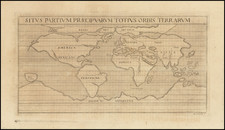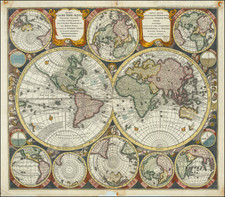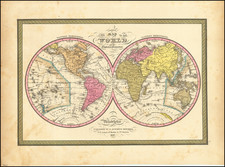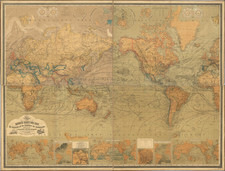Карта Часовыхъ Поясовъ, issued by the Chief Hydrographic Office in 1919, presents a unique depiction of the international time-zone system, an innovation that the Russian Soviet Republic adopted in its navy in 1918. This system divided the Earth into 24 zones, each representing one hour of time difference, with the 0 meridian passing through Greenwich.
The map is noted for its innovative use of color and line styles to represent various geographical and temporal distinctions. On the map, time-zone boundaries are shown at sea as continuous black lines and on land as dotted lines with variable coloration. States or provinces that have adopted standard zone time are color-coded: red for even-numbered zones and blue for odd-numbered zones. Areas where the standard time differs by 30 minutes from zone time are marked in purple. Countries that have not adopted the system are colored yellow.
The map also provides specific time indications for countries that have not adopted the time-zone system (depicted in yellow), but which base their standard time on the principal State Observatory. The difference between local and Greenwich Mean Time is indicated next to the name of the observatory.
The map also employs Roman numerals next to place names to specify the time-zone number or half-zone in cases of potential confusion. This applies to certain seas, bays, and river mouths adjacent to countries that have not adopted zone time.
The map also depicts the International Date Line, marked in green. Outside territorial waters, ships change the date upon crossing the 180° meridian. On land and on islands, an arbitrary border line has been adopted. On either side of this line, the days of the week and the dates differ by a full day, with the date for a location in the West following that of a location in the East.
Borders of countries are marked with crosses in two specific situations: 1) for the borders of countries that have adopted the time-zone system, if their borders do not coincide with the zone boundaries; 2) for the borders of countries that have not adopted the system, if the delineation of their borders allows for the determination of the time (based on the main time of the principal Observatory) in the coastal regions of the country.
This historical map provides a compelling glimpse into the transitional period of the early 20th century when international timekeeping norms were being standardized. By featuring the use of color coding and innovative mapping techniques, it embodies the fusion of time and space in geographical representation and stands as a testament to a global movement towards timekeeping standardization and coordination.











![[ World ] Nova Totius Terrarum Orbis Geographica Ac Hydrographica Tabula Auct. Henr: Hondio. . . . 1641](https://storage.googleapis.com/raremaps/img/small/85386.jpg)

![Newsmap. Monday, June 29, 1942 [on verso:] Our Fighting Ships](https://storage.googleapis.com/raremaps/img/small/93346.jpg)
